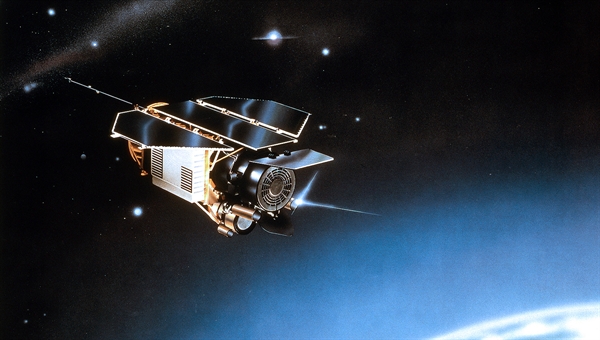 |
| ROSAT-1 (source: http://www.dlr.de/ ) |
ROSAT was the second large satellite to fall to Earth in as many months. NASA’s 6 tonne UARS satellite fell into the southern Pacific Ocean in late September. It also broke up and may have spread fragments over an 800 km debris field. So far there have been no reports of debris sightings from either satellite.
Space junk is a term used to describe the millions of objects created by humans that are in orbit around the Earth but no longer serve any useful purpose. Most of these are smaller than 1 cm, particles like paint flakes and particulates from solid rocket fuels. These small fragments pose a problem for operating satellites because they can cause significant abrasion, rather like sandblasting, damaging mirrors, solar panels and other parts of the craft. But there are also tens of thousands of larger particles, including about 20,000 objects weighing more than 100 kg, and these are a real danger. According to the National US Academy of Sciences a 1 kg piece of space junk impacting at 10 km per second could destroy a 1000 kg spacecraft creating many more dangerous fragments in the process.
As pieces of space junk orbit the Earth, friction or drag from the upper atmosphere slows them down, and as they slow they are unable to maintain their orbits and begin to spiral downwards. Most fragments ‘burn up’ due to the heat created by friction as they speed through the denser lower atmosphere, but some satellites contain parts that are specifically designed to withstand high temperatures. NASA estimates that about 26 pieces of the UARS satellite, weighing a total of 530 kg, probably survived. And the ROSAT satellite had large ceramic mirrors and a carbon-fibre composite support structure which may have survived re-entry.
One of the things that often puzzles people is why scientists, who can accurately predict the paths of comets and other objects in distant outer space, have such a lot of trouble predicting when and where falling space junk will hit the ground. One factor that affects their trajectory is how they tumble and turn as they re-enter the atmosphere. Because satellites often have a very irregular shape, differences in how they tumble can have a big difference on the amount of drag as they fall.
Another important and difficult to predict factor is solar activity. Periods of high solar activity result in the Earth’s outer atmosphere warming and expanding, increasing the drag on satellites and making them fall to Earth more quickly. In fact we can probably expect a higher rate of space junk re-entry as we approach a solar maximum in 2013.
So should we all rush out and buy hard hats? Probably not. Since the 1990’s space agencies have adopted new procedures to decrease the threat from space junk including a move towards smaller satellites, and NASA assures us that it has no large satellites that will make an uncontrolled re-entry in the next 20 or so years. And while the risk of injury from the falling UARS craft was estimated by NASA to be 1 in 3000, and the risk from ROSAT about 1 in 2000, NASA and some foreign space agencies now seek to limit human casualty risks from reentering space objects to less than 1 in 10,000. Indeed, despite all the space junk out there I can only find one credible report of injury. In 1969 five Japanese sailors were injured by an object that may have been space junk of Russian origin.
Maybe the sky isn’t falling after all.

No comments:
Post a Comment